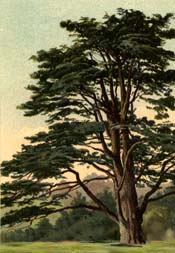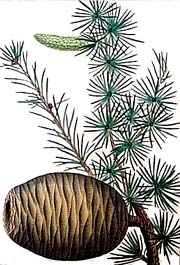|
 Cedrus libani Cedrus libani
Cedar of Lebanon
This tree has been beloved by humans for many
ages. Ancient residents of
Tyre, Byblos, and Sidon built their houses and
ships from this tree, and the Egyptians used it for sarcophagi and the
ceremonial barge of the
Sun-god Amun-Ra. In Ur, Mesopotamia (now
Iraq), this tree was connected with a local mother goddess, but when
the idol-maker Abraham left Ur and planted a grove sacred to YHVH, the seeds
he chose were these. King Solomon built the Temple from this wood, and asherahs,
goddess figures that were "illegally" displayed in Hebrew temples all over the ancient
lands
of Israel and Judea, were made from this wood (it is said that while
Solomon's
Temple stood, the Sun and Moon shone with equal light, representing the
equality of masculine and feminine spirituality). The Hebrew Bible
designated this Sun plant as the king of trees. The cedar of Lebanon was also associated with
Baal, who is often depicted holding this tree and whom some consider the
equivalent of the storm aspect of Set. The wood was much used
by the Phoenicians and ancient Greeks (who saw in it a symbol of
Persephone's time in the Underworld). This tree is often connected to
Sun gods, although in Turkey it was traditionally associated with
Artemis. Top
 In the Dark Ages, Jews burned this wood to celebrate the New Year. It's
great for Solomonic magick, good for purification and protection, and represents
incorruptibility and eternal life in the language of flowers. Many
incorporate it into celebrations of Imbolc, and it is said to repel
snakes. The needles of this tree grow in a spiral, a shape historically
associated not only with goddess forms but also with the Sun. This all-purpose
tree for magick also makes
a good specimen tree in a yard and a great bonsai tree. It's very
similar to Atlas cedar (see essential oils) but has a thicker trunk. A
native of Lebanon, Syria, and Turkey, cedars of Lebanon have been cultivated in Europe since the 1700s. Top In the Dark Ages, Jews burned this wood to celebrate the New Year. It's
great for Solomonic magick, good for purification and protection, and represents
incorruptibility and eternal life in the language of flowers. Many
incorporate it into celebrations of Imbolc, and it is said to repel
snakes. The needles of this tree grow in a spiral, a shape historically
associated not only with goddess forms but also with the Sun. This all-purpose
tree for magick also makes
a good specimen tree in a yard and a great bonsai tree. It's very
similar to Atlas cedar (see essential oils) but has a thicker trunk. A
native of Lebanon, Syria, and Turkey, cedars of Lebanon have been cultivated in Europe since the 1700s. Top
How to Grow
It
|
Cedrus libani
10 seeds
$3.75

Uses
in Witchcraft & Magic:
Solomonic Magic
Honoring YHVH, Artemis,
and Sun deities
Purification
Protection Spells
Sun herb
|